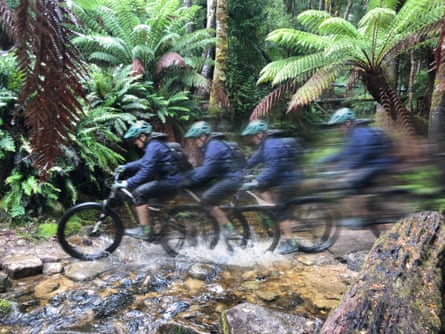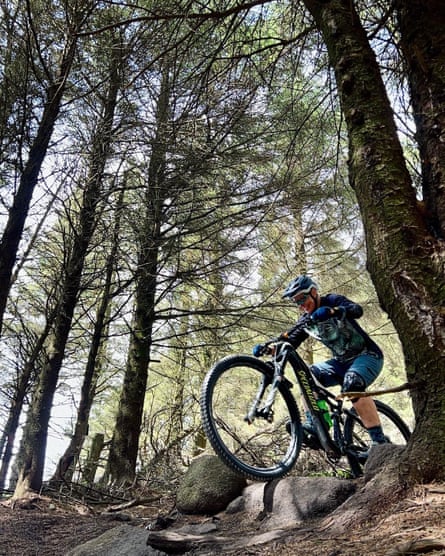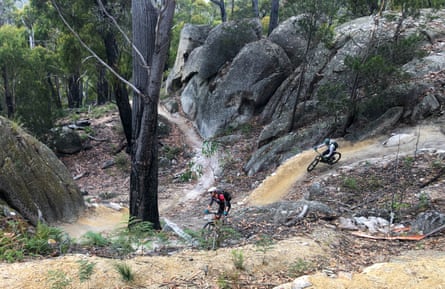
It wasn’t the news my doctor expected from the scan. I could tell by the look on his face. Most partial hearing loss episodes are caused by infections. I was that rare, one-in-whatever-thousand case where they’d discovered a squatter – which I now call “the thing” – was hanging out in my head.
“It’s a brain tumour,” he said.
“Delivering this news to people doesn’t get any easier, does it?” I responded, rhetorically, just before the tsunami hit.
Then my heart raced. I gasped for air. I felt as if I’d been yanked under water with debris hurtling towards me from every angle. I stayed wedged in this vomit-level state of fear for weeks through a rollercoaster of treatment “options” explored with a string of various-ologists. “We think it’s small and slow-growing,” said specialist number one. “Unfortunately, yours is in a very bad place,” said specialist number two as he took the brain out of his model skull and pointed to the cranial nerves at the base. Specialist number three: “It’s inoperable, I’m afraid.”
Fortunately, a final stop at specialist number four offered radiotherapy treatment that had an over 80% success rate at stopping tumours like mine in their unthinkable, nerve-destroying tracks. But the fact that the thing moved slowly meant I’d face years of comparison scans and cliff-hanging monitoring before the bad-movie experience could end.
For six uncertain years, getting my ruminating mind to “shut it” has been the hardest challenge. A blaring, nonstop tinnitus soundtrack like a 1950s transistor tuning in was an unwelcome gift from the thing. But alongside the cacophony of hissing and whistling, a general medical mantra also rang in my ears: “Try to do what’s normal.”
My normal is mountain biking. At first glance, people would be forgiven for thinking mountain biking isn’t perhaps the best pastime for dealing with turmoil, or tumours. Especially not tougher features like the sandstone shelves that form the trails around my Sydney locale. Balancing braking, gear-shifting, transferring body weight and pushing momentum at just the right time to stop a fun day out ending in an overly familiar relationship with a tree? But, as ridiculous as it sounds, the undivided attention required to carry out a risky activity turned out to be a mind trick that worked. It pushed force-quit on my incessant “what if”.
“Difficult mountain biking requires high levels of concentration and takes up more ‘brain bandwidth’,” says Dr Julian Oldmeadow, senior lecturer in psychological sciences at Swinburne University of Technology. “So the mind has to stay focused on the task and can’t drift into other thoughts.”
That’s why riding down a slab of rock (within my skill level) got “the thing” out of my head. Metaphorically speaking.
Moreover, maintaining focus is a good habit to get into because in this high-concentration mode, we hurtle towards the holy grail of mountain biking – a transcendent state of flow.
“Getting in the flow” on “flow trails” is part of the mountain biking lingo. These rhythmic ribbons of dirt, with heart-leaping rollers – designed for momentum – keep you pumping and weaving through the forest, if you dare to stay off the brakes.
There are networks specifically designed for mountain bikes, with colour-coded trails that match skill levels (similar to ski runs) to help us find it.

But we weren’t the first to flow. That would be pioneering co-founder of positive psychology, Mihaly Csikszentmihalyi. He first described the phenomena of flow in the 1970s, coined the term from the feeling of being carried along by water, and spent decades researching it.
The late Csikszentmihalyi found individuals were their most creative, productive and happy when in flow state: “An activity that produces … experiences is so gratifying that people are willing to do it for its own sake, with little concern for what they will get out of it, even when it is difficult, or dangerous,” he wrote in his bestselling book Flow.
Csikszentmihalyi argues that when you’re less concerned with yourself, it frees up mental energy to participate in the world on its own terms. You can learn to grow beyond the limits of your own self-centredness.
Flow is the hidden power of complete mindfulness; a hyper-focused yet uber-tranquil state of mind. The universal experience also described as “being in the zone” can come from a diverse range of activities, from piano playing to rock climbing.
The science tells us that flow happens when we’re doing something we love and leaves behind a swag of lingering wellbeing fuzzies. Oldmeadow says it’s a form of moving meditation where a sense of fluidity between the mind and body mean tasks are accomplished without us having to think about it.
He notes commonalities between the flow experience and Buddhist concepts, such as letting go of thoughts and emotions. A boost in self-confidence and self-esteem is also universally reported across studies. “But there are still a lot of unanswered questions about how flow works,” Oldmeadow says. Flow can be tempted, “but you can’t force it to happen”.
Csikszentmihalyi also described the many spinning plates that must line up to access states of flow. Internal elements (such as focus and skills) must be met with external circumstances (such as challenge and risk) until everything suddenly “clicks”. Then time is distorted, testing tasks feel effortless and worries simply melt away.
The sweet spot, as Csikszentmihalyi explains it, is at the perfect intersection of challenge and skill.

In recent years, flow has eluded me for obvious reasons. But I found it again in Blue Derby, a network of trails in the native rainforest of north-east Tasmania. Flow requires riding trails with features that stretch my skills to the hilt but don’t push them to through the jittery ceiling, where harmony is lost and fear sets in.
A rich environment is another condition thought to encourage the mind state, and doesn’t get any more illustrious than Blue Derby’s monolithic granite boulders which guard tunnels of giant tree ferns, as branches drip near-fluorescent moss and shards of light pierce dark volcanic dirt. Each year, tens of thousands take a pilgrimage there to gulp some of the planet’s cleanest air before plunging into 125km of world-class single track repurposed from old tin-mining trails.
I joined them when I fearlessly rolled over car-sized boulders, confidently rode into giant sweeping berms (banked corners) and effortlessly danced over chaotic rock beds.
Flow might be a fickle and unpredictable friend who only shows up when everything is just right, but after getting reacquainted, I’ve also learned there is joy in getting out there to see if it wants to play. A lot of healing and growth has come out of our flirty relationship over the past few years.
Recently, I got my “see ya” sign-off from specialist number four. “Come back if you feel any significant changes, but at this point I think we can be confident that all the cells are dead,” she said.
Csikszentmihalyi wrote: “The best moments in our lives are not the passive, receptive, relaxing times … The best moments usually occur if a person’s body or mind is stretched to its limits in a voluntary effort to accomplish something difficult and worthwhile.”
I can testify this effort has been more than worthwhile for me.


